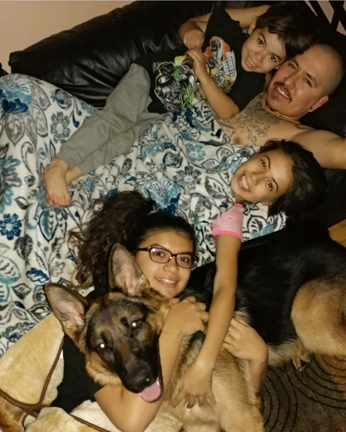It’s that phone call no one wants to get – a loved one has been in a traffic accident. But when living and driving in Southern California, the chances are high that a call will come, and chances are even higher if the driver is on a motorcycle.
That dreaded call came in to a local family on April 9 just after 7 a.m.
“It was horrible,” said Jessie Bobadilla, a Crescenta Valley High School alumna and local resident.
That is how she described the phone call she received from her husband, Juan Garcia, from the Foothill (210) Freeway. Garcia had been driving on the 210 Freeway and was admittedly lane splitting when a car weaved into his lane and collided with his motorcycle. According to the California Highway Patrol report, the driver of the car that collided with the motorcycle stated she had looked to her side and the motorcycle seemed to come out of nowhere.
CHP and the Dept. of Motor Vehicles regard lane splitting as neither legal nor illegal. The decision to lane split is the responsibility of the motorcyclist and anyone driving along Southern California freeways is aware of the lane splitting practice.
The motorcycle and vehicle collided and Garcia was sent skidding across the pavement. The driver of the vehicle stopped and called 911.
According to Bobadilla, one vehicle pushed her husband’s motorcycle into a second vehicle, which is when he laid his bike down onto the pavement. The CHP report stated there are more witnesses and the investigation is ongoing.
For Bobadilla, how the accident occurred was not on her mind when she received that call; all she wanted to do was to get to the hospital and be with her husband.
“I didn’t know the extent of the injuries at first,” she said. “I was so scared and [just] wanted to get to the hospital.”
Because her husband had called from the accident site, she had thought he wasn’t too badly injured, but when she got to the hospital she found it was more serious than she thought. Garcia had five broken bones that required two surgeries that placed metal plates and screws in his arm, wrist, knee, shin and ankle. In addition, the impact affected Garcia’s chest and lungs to the extent that he was on oxygen for eight days while in the hospital.
Garcia cannot walk and requires 24-hour care, which is provided by Bobadilla with the help of the couple’s three young children. Garcia is well-known in the community; he has worked at Pepe’s in Montrose and Taylor’s Steak House in La Cañada. He will be off work, doctors say, for about three months.
“He has a lot of customers who are concerned,” Bobadilla added.
The toll of the hospital bills and the fact that Garcia cannot work has taken a toll on the couple’s finances. They have started a gofundme page. Anyone wishing to help the family can do so by visiting www.gofundme.com/juanbobadilla.
Bobadilla said that although the injuries are serious it could have been a lot worse. Garcia was wearing a quality motorcycle helmet and did not suffer a concussion, a common injury in motorcycle accidents.
Garcia joins a growing U.S. statistic of motorcycle accidents. In 2017, nationwide, there were 88,000 non-fatal motorcycle accidents. A preliminary report by the GHSA – Governors Highway Safety Association – estimated that the number of motorcyclist deaths in 2012 was more than 5,000, a 9% increase over 2011.
May is Motorcycle Safety Month. California has more registered motorcycle drivers than any other state with 893,107 as of January 2017, according to the California Dept. of Motor Vehicles.
In 2013, more than 4,600 motorcycle fatalities were reported throughout the country.
“There are a lot of causes,” said CHP Officer Garcia (no relation to the Bobadilla’s husband). “People are distracted and not watching for motorcycles. I see it all the time. People are on their cellphones and motorcyclists have to rev their engines [to get the driver’s attention].”
He said a lot of times distracted drivers will drift into other lanes, which causes issues, especially when motorcycles are lane splitting. He added motorcyclists also have to be aware and be ready to reduce their speed.
“[Motorcycle drivers] need to slow down. A lot of time they are going too fast and it is too late to react to [issues],” he said.
“One of the most common reasons drivers give for cutting off or pulling out in front of a motorcycle is that they ‘didn’t see it,’” according to AAA.
Below are some examples of how motorcyclists can prevent crashes and injuries:
•Keeping headlights and marker and taillights on at dusk and in dark or rainy weather
•Staying three to four seconds behind a vehicle they intend to pass, checking oncoming traffic from the left side of the lane, signaling the intention to turn, and then checking for oncoming traffic before passing.
•Checking their rearview mirror and quickly turning their head to ensure the vehicle is a safe distance behind them when completing a pass
•Wearing helmets that meet a high protection standard
•Wearing proper clothing, eyewear and sturdy, closed-toe footwear
Motorists can help to make the roads safer for motorcyclists by taking some simple precautions:
•Be extra cautious on weekends, when more motorcyclists take to the road.
•Provide motorcyclists adequate room to maneuver. Follow at least three to four seconds behind them.
•Allow extra maneuvering room in areas with potholes, pavement transitions and railroad crossings. Motorcyclists may need to slow down, stop or adjust their lane position.
•Never try to share a lane with a motorcycle. Motorcycles have the same right to lanes as any other vehicle.
•If a motorcycle is nearby, check mirrors carefully before changing lanes. Motorcycles may be in blind spots or be difficult to see because of their smaller size.


